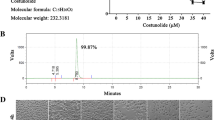Abstract
Background
Gastric cancer is one of the serious malignant tumors with high incidence worldwide. The two commonly used treatment strategies for gastric cancer include chemotherapy and radiation therapy. Conventional anticancer drugs have limited effectiveness. Therefore, it is important to explore new anticancer drugs. Dehydroabietic acid (DAA) is known to have anti-bacterial, anti-inflammatory, and anticancer effects. However, there are fewer reports on the effect of DAA on human gastric cancer cell lines.
Objective
We investigated the gastric cell growth inhibitory effects of DAA on human gastric cancer cell lines. Gastric cancer cell proliferation, apoptosis and cell cycle arrest assay were detected by WST assay, crystal violet staining assay, Flow cytometry, RT-PCR and western blot analysis.
Results
These results showed that as the concentration of DAA increased, the proliferation inhibitory effect appeared in gastric cancer cells. In addition, DAA induced sub-G1 phase accumulation and G1 cell cycle arrest, and subsequently induced apoptosis in AGS and YCC-2 cells. In addition, the expression of the pro-apoptotic Bax was upregulated, and that of the anti-apoptotic Bcl-2 was downregulated in DAA-treated AGS and YCC-2 cells. Moreover, DAA induced the cleavage of caspase-3 and PARP.
Conclusion
These results suggest that DAA induces cell death through mitochondria-mediated apoptosis and G1 cell cycle arrest. Therefore, our results indicate the anticancer and therapeutic potential of DAA for treatment of human gastric cancer.




Similar content being viewed by others
References
Bailon-Moscoso N, Cevallos-Solorzano G, Romero-Benavides JC, Orellana MI (2017) Natural compounds as modulators of cell cycle arrest: application for anticancer chemotherapies. Curr Genom 18:106–131
Besson A, Dowdy SF, Roberts JM (2008) CDK inhibitors: cell cycle regulators and beyond. Dev Cell 14:159–169
Danial NN (2007) BCL-2 family proteins: critical checkpoints of apoptotic cell death. Clin Cancer Res 13:7254–7263
Frenzel A, Grespi F, Chmelewskij W, Villunger A (2009) Bcl2 family proteins in carcinogenesis and the treatment of cancer. Apoptosis 14:584–596
Fulda S, Debatin KM (2006) Extrinsic versus intrinsic apoptosis pathways in anticancer chemotherapy. Oncogene 25:4798–4811
Gim J, Kim HS, Kim J, Choi M, Kim JR, Chung YJ, Cho KH (2010) A system-level investigation into the cellular toxic response mechanism mediated by AhR signal transduction pathway. Bioinformatics 26:2169–2175
Hosseini A, Ghorbani A (2015) Cancer therapy with phytochemicals: evidence from clinical studies. Avicenna J Phytomed 5:84–97
Jiang X, Wang X (2004) Cytochrome C-mediated apoptosis. Annu Rev Biochem 73:87–106
Jung KW, Won YJ, Kong HJ, Lee ES, Community of Population-Based Regional Cancer R (2018) Cancer statistics in Korea: incidence, mortality, survival, and prevalence in 2015. Cancer Res Treat 50:303–316
Kamb A (1995) Cell-cycle regulators and cancer. Trends Genet 11:136–140
Kang HG, Kim WJ, Kang HG, Chun KH, Kim SJ (2020) Galectin-3 interacts with C/EBPbeta and upregulates hyaluronan-mediated motility receptor expression in gastric cancer. Mol Cancer Res 18:403–413
Kim R, Tanabe K, Uchida Y, Emi M, Inoue H, Toge T (2002) Current status of the molecular mechanisms of anticancer drug-induced apoptosis. The contribution of molecular-level analysis to cancer chemotherapy. Cancer Chemother Pharmacol 50:343–352
Krukiewicz K, Zak JK (2016) Biomaterial-based regional chemotherapy: Local anticancer drug delivery to enhance chemotherapy and minimize its side-effects. Mater Sci Eng C Mater Biol Appl 62:927–942
Kweon SS (2018) Updates on cancer epidemiology in Korea, 2018. Chonnam Med J 54:90–100
Li P, Nijhawan D, Budihardjo I, Srinivasula SM, Ahmad M, Alnemri ES, Wang X (1997) Cytochrome c and dATP-dependent formation of Apaf-1/caspase-9 complex initiates an apoptotic protease cascade. Cell 91:479–489
Lim S, Kaldis P (2013) Cdks, cyclins and CKIs: roles beyond cell cycle regulation. Development 140:3079–3093
Lowe SW, Lin AW (2000) Apoptosis in cancer. Carcinogenesis 21:485–495
Luo D, Ni Q, Ji A, Gu W, Wu J, Jiang C (2016) Dehydroabietic acid derivative QC4 induces gastric cancer cell death via oncosis and apoptosis. Biomed Res Int 2016:2581061
Pfeffer CM, Singh ATK (2018) Apoptosis: a target for anticancer therapy. Int J Mol Sci 19
Porter AG, Janicke RU (1999) Emerging roles of caspase-3 in apoptosis. Cell Death Differ 6:99–104
Senderowicz AM (2002) The cell cycle as a target for cancer therapy: basic and clinical findings with the small molecule inhibitors flavopiridol and UCN-01. Oncologist 7(3):12–19
Siegel RL, Miller KD, Jemal A (2018) Cancer statistics, 2018. CA Cancer J Clin 68:7–30
Sitarz R, Skierucha M, Mielko J, Offerhaus GJA, Maciejewski R, Polkowski WP (2018) Gastric cancer: epidemiology, prevention, classification, and treatment. Cancer Manag Res 10:239–248
Thoppil RJ, Bishayee A (2011) Terpenoids as potential chemopreventive and therapeutic agents in liver cancer. World J Hepatol 3:228–249
Wang IK, Lin-Shiau SY, Lin JK (1999) Induction of apoptosis by apigenin and related flavonoids through cytochrome c release and activation of caspase-9 and caspase-3 in leukaemia HL-60 cells. Eur J Cancer 35:1517–1525
Yip KW, Reed JC (2008) Bcl-2 family proteins and cancer. Oncogene 27:6398–6406
Acknowledgements
This study was supported by the Chosun University in 2020.
Author information
Authors and Affiliations
Contributions
Conception, design and funding: SJK; isolation, identification, experiments: WJK and HGK; writing the manuscript: WJK and SJK; reviewed the manuscript: all the authors.
Corresponding author
Ethics declarations
Conflict of interest
The authors declare no conflict of interest.
Ethical approval
This article did not contain studies of human tissues and animals that required experimental permission, and institutional and national guidelines were also performed in this study.
Additional information
Publisher's Note
Springer Nature remains neutral with regard to jurisdictional claims in published maps and institutional affiliations.
Rights and permissions
About this article
Cite this article
Kim, WJ., Kang, HG. & Kim, SJ. Dehydroabietic acid inhibits the gastric cancer cell growth via induced apoptosis and cell cycle arrest. Mol. Cell. Toxicol. 17, 133–139 (2021). https://doi.org/10.1007/s13273-021-00118-9
Accepted:
Published:
Issue Date:
DOI: https://doi.org/10.1007/s13273-021-00118-9




